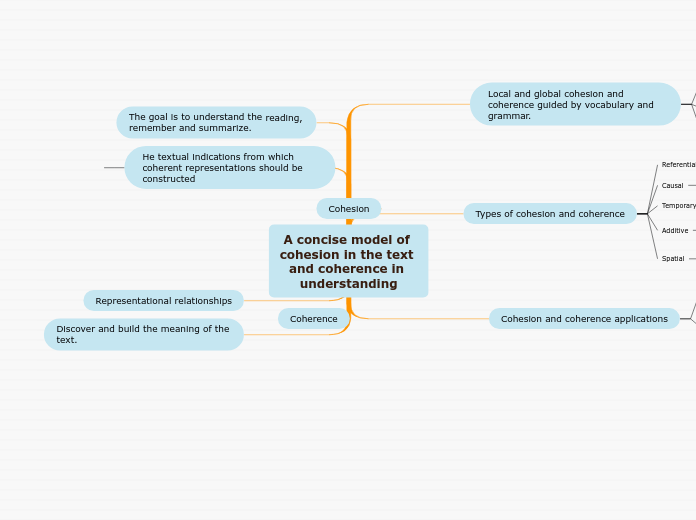Coherence
Where to next?
When you have a comprehensive description of the problem, you can move towards finding solutions.
Consider brainstorming as a next step or Share the mind map with your colleagues.
A concise model of cohesion in the text and coherence in understanding
Name the problem
Identify the problem or issue in a few words and press Enter. This will become the title of your map.
Discover and build the meaning of the text.
Representational relationships
Cohesion
He textual indications from which coherent representations should be constructed
Add an assumption
Identify an assumption you are making in both the description of the problem and the logical solution.
- What would happen if the assumption changed?
- What if the assumption is not valid?
- Might different assumptions also apply?
The goal is to understand the reading, remember and summarize.
Cohesion and coherence applications
Theories, evidence and applications of cohesion and coherence.
Its objective was not to provide a complete picture, but to highlight some of the ongoing research in a range of interdisciplinary areas, including psycholinguistics, computational linguistics, corpus linguistics, and literary studiesnvestigating how cohesion affects coherence.
More recently, McNamara, Louwerse and Graesser
Add solution criteria
Make sure you consider:
- Minimum acceptable success criteria
- Meeting constraints on solutions, e.g. cost, time, resources
- Ensuring that the symptoms will disappear
- Resolving the impact on various users
- Addressing the root causes
- Validating the solution against known data
Types of cohesion and coherence
Spatial
Consistency in which events occur marked by adverbial phrases or points of view. Events are spatially cohesive if they share the same place.
Additive
Unspecified information between events related to the addition.
Temporary
Time in which certain events occur and often signaled by the verb tense.
Causal
Facts of two sentences that are related.
Referential
consists of that or that to whom reference is made, often indicated by anaphora.
Local and global cohesion and coherence guided by vocabulary and grammar.
Add an unknown factor
Identify information or data that is not known or not reliable, and what you can do to find it. Think about:
- Missing information
- Information that could be unreliable
- Information from reliable sources that is factually wrong
- Other people who might have useful information or experience
Local cohesion joins adjacent textual units, while global cohesion joins larger chunks of textual units.
Can be described in terms of micro and macrostructures.
Grammar-driven cohesion can occur alongside vocabulary-driven cohesion, and it has been argued that both interact in the emergence of coherence.

